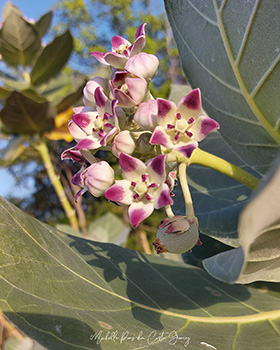On the side of very busy roads, on recently bulldozered terrains and especially on places where the air pollution is considerably higher, you will find this plant, often considered a weed, but when deliberately groomed, a beautiful garden plant and also the host of one of the most beautiful butterflies on the island; the Monarch. Meet the plant named Katuna di Seda, Katúnbóm, Mata di lechi (Calotropis procera) or Milkweed. It is an introduced plant on Aruba, Bonaire and Curaçao and all of the New World and originally comes from the African or Asian continent. As an introduced species it is now used by native Monarch butterflies as a host plant for their caterpillars.

The purple flowers attract especially ants which are likely to be the main pollinators of the plant. The plant itself contains a milk like substance that can cause severe irritation on skin and in eyes, if touched with dirtied fingers.
English name: Milkweed
Papiamentu/Papiamento name: Katuna di seda (Curaçao), Mata di lechi/ Catunbom (Aruba), Katúnbóm (Bonaire)
Scientific name: Calotropis procera
Family: Apocynaceae (Dogbane family)
Occurrence (ABC islands): Aruba, Bonaire and Curaçao (introduced)

Wilde bloemen : Calotropis procera
Aan de kant van zeer drukke wegen, op onlangs gebulldozerde terreinen en vooral op plaatsen waar de luchtvervuiling aanzienlijk hoog is, vindt u deze plant, vaak beschouwd als onkruid, maar wanneer goed verzorgd, een prachtige tuinplant en ook de gastheer van één van de mooiste vlinders op het eiland; de Monarch. Maak kennis met de plant genaamd Katuna di Seda, Katúnbóm, Mata di lechi (Calotropis procera) of Milkweed. Het is een geïntroduceerde plant op Aruba, Bonaire en Curaçao en de hele Nieuwe Wereld en komt oorspronkelijk van het Afrikaanse of Aziatische continent. Als geïntroduceerde soort wordt het nu door inheemse Monarchvlinders gebruikt als waardplant voor hun rupsen.

De paarse bloemen trekken vooral mieren aan, die waarschijnlijk de belangrijkste bestuivers van de plant zijn. De plant zelf bevat een melkachtige substantie die ernstige irritatie op de huid en in de ogen kan veroorzaken, als deze met vuile vingers wordt aangeraakt.
Nederlandse naam: –
Papiamentse naam: Katuna di seda (Curaçao), Mata di lechi/ Catunbom (Aruba), Katúnbóm (Bonaire)
Wetenschappelijke naam: Calotropis procera
Familie: Apocynaceae (Maagdenpalmfamilie)
Voorkomen (ABC eilanden): Aruba, Bonaire en Curaçao (Geïntroduceerd)